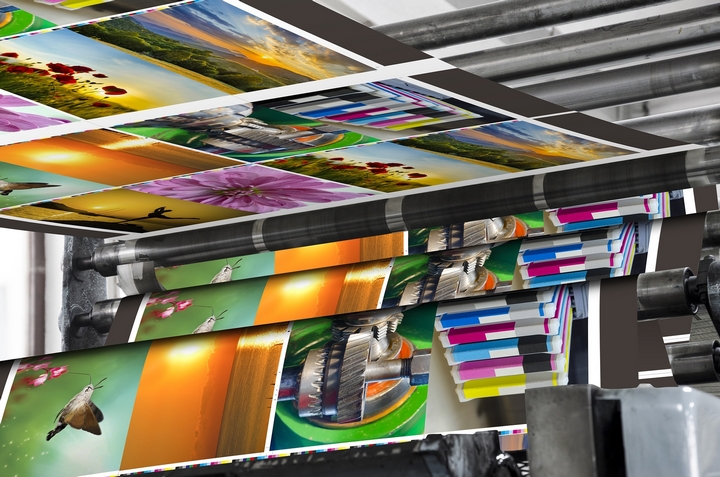
Printing is the process of reproducing text and images from a plate, although that definition continues to evolve with the introduction of new technologies. The Ancient Chinese developed a simple woodblock printing method more than 1,800 years ago, and printmaking has remained an art form in many countries ever since. From the publication of the first printed Bible made using Johannes Gutenberg’s printing press in the 15th century, printing has had a massive impact on literacy and the spread of information. Even in the digital age, printing continues to play an inspiring role in commerce, industry, and knowledge.
Industrial printing involves varied tools where different printing methods can produce very different results. Each method has its own benefits and disadvantages. Learning to distinguish between these printing methods will help you to achieve the best results for a specific printing project. Some of the most popular printing methods include:
1. Offset printing

Popular for the printing of newspapers, magazines, stationery, brochures, books, and much more, offset printing is among the most common printing methods used today. In offset printing, an image of the content to be printed is transferred (or “offset”) from a soft metal plate to a rubber blanket, which then is inked and transferred to a printable surface.
Offset printing can print on most materials that have a perfectly flat surface, including paper, cardboard, and plastic. Modern offset printing uses a computer-to-plate process, where the plated image is created from a computer file. With its high print quality, offset printing is ideal for printing in large quantities.
2. Rotogravure printing

In rotogravure printing, a desired image is engraved onto a cylinder. Unlike relief printing processes like offset printing or flexography, in which ink is applied to the pronounced edges, rotogravure printing is a method of intaglio printing, which involves applying ink directly into small pockets on the roller. This way, during printing, ink is applied in total onto the printed material, rather than being pressed onto it. The result is that rotogravure printing transfers much more ink to the printed service than most other printing methods.
The rotogravure printing method produce a much more dramatic range of lights and darks, making it very popular for reproducing fine art and photography. For many years, rotogravure printing was used in printing photos for newspapers. Today, rotogravure is used for commercial printing, postcards, magazines, cardboard and product packaging. It is also in demand for its ability to print on thin film, like product packaging. It is excellent for reproducing images, but text can appear jagged. This method can also be costly, especially at the outset.
3. Flexography

Flexographic printing takes its name from the flexible relief plate that it is uses to deliver excellent results for packaging, labels, wallpaper, gift wrap, and any other surface that has a continuous pattern. Flexography can be used for printing substrates of all kinds, including paper, plastic, cellophane, metallic films, and more.
Modern flexography has undergone significant refinement in recent years with important advances being made to the quality of the process and its materials. Flexography now has the capacity for to print in high quality HD and full-colour.
4. Digital printing

In digital printing, the text or image to be printed exclusively comes directly from digital files, and there is not a printing plate. Digital printing involves a range of methods using inkjet printing or laser printing. In inkjet printing, the ink is actually jet-propelled on to the printed surface. Laser printing uses rapidly moving lasers to transfer powdered ink (called toner) to paper, which is heated to fuse the ink into place. Digital printing is a cost-effective and fast printing method.
Unlike other printing methods, digital printing is great for small jobs, including printing a single page. It is very popular for business and home use, where it delivers great results for is signs and posters, labels, newsletters, menus and personal documents.
5. Screen printing

Screen printing has been used in Asian countries for over 1000 years. In the 1960s, Andy Warhol brought this method to the world of fine art, where its distinctive appearance continues to be popular. Screen printing involves pressing ink through small holes in a screen or mesh with different colours applied in separate layers. Screen printing is a versatile printing method popular for printing logos or graphics onto T-shirts and other clothing, or for making banners or posters.
In addition to fabrics, it can also be used to print onto paper and metal. Screen printing is labour intensive and requires a lot of preparation, making it great for printing the same image over and over again. It is not a cost-effective printing method for small orders and the image is lower quality than in more refined printing methods.
6. 3D printing

Dating to the 1980s, 3D printing is a way of actually manufacturing three-dimensional objects. It uses a compound mixture that is fused together layer by layer. Working from a computer-aided design (CAD) model, 3D printing can make almost anything.
The novelty of 3D printing really makes an impact, and many printing shops set up displays of objects they’ve printed, including toys, promotional items, and novelty objects. Post-printing finishing or refining is often required. 3D printers are becoming increasingly sophisticated. A slow process, they now have the ability to print using multiple materials and even make objects with moving parts.